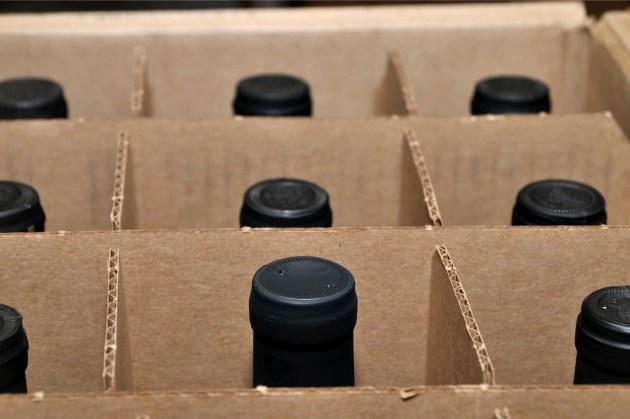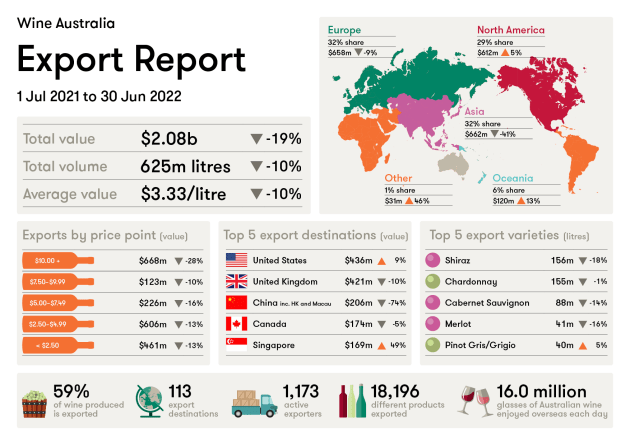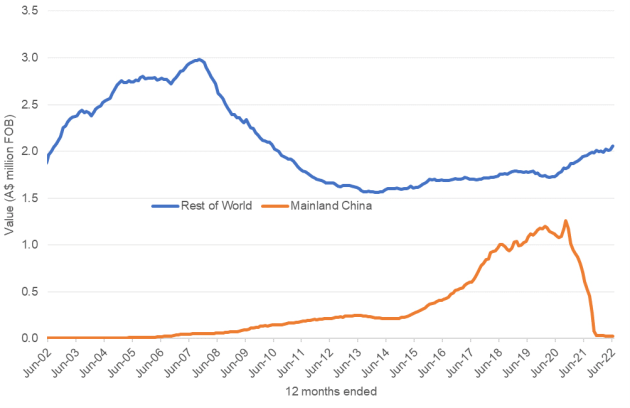Wine Australia (WA) says while the latest wine export report shows a sizeable fall in value and volume due to ongoing tariffs in mainland China, there are encouraging signs in other markets. The FY22 report found exports fell 19 per cent in value and 10 per cent in volume in the year, with the market now worth $2.09 billion.
The falls were not unexpected, WA said, with high tariffs imposed by China in 2020 still causing significant reductions in exports to mainland China. WA said it expected that to stay a major influence on exports until late 2022.
Wine Australia manager Market Insights, Peter Bailey, said the operating environment for exporters had been extremely challenging with the Chinese tariffs, ongoing pandemic impacts – including severe shipping delays and increased freight costs – and rising inflation, business costs, and interest rates.
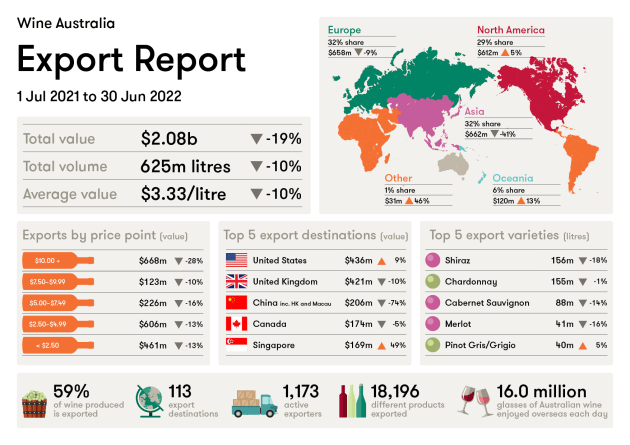
But there were some encouraging signs, Bailey said.
“When mainland China is excluded from the data, exports increased by five per cent to $2.06 billion, an increase of $105 million – the highest value since FY10.
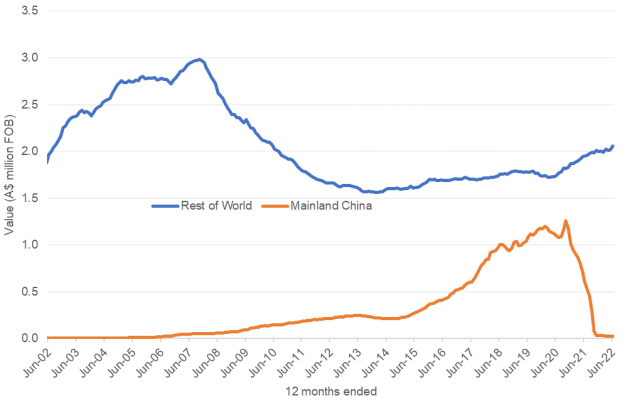
“This is despite volume declining by three per cent to 619 million litres. The value growth for these markets was driven by a nine per cent increase in average value to $3.32 free on board (FOB*) per litre,” he said.
Key contributors to value growth were Singapore, the US, Malaysia, Thailand, India, and New Zealand.
Bailey said markets that experienced growth were driven by exports in higher value segments, at $10 or more FOB per litre.
“This reflects the wine sales trends in many markets around the globe, which have seen a downward trend in commercial/value sales (less than US$10 per bottle retail) and sales growth in premium and above segments (US$10 or more per bottle retail).
“The above $10 or more FOB per litre price segment helped drive overall value growth to the US, which has returned to Australia’s top destination by value, and there was also a significant increase in the number of companies exporting to the US,” Bailey said.
In FY22, Australian wine exporters shipped to 113 destination markets. At a region level, the most significant growth came from exports to Southeast Asia, up 51 per cent to $314 million, but also to North America, up five per cent to $612 million, and the Middle East, up 48 per cent to $20 million.
This growth was offset by a decline in exports to Northeast Asia (including mainland China), down 64 per cent to $328 million, and Europe, down nine per cent to $658 million.
Excluding mainland China, there was growth in all price segments at $5 or more FOB per litre, except the top segment of $200+ per litre. The strongest growth came at $10 or more per litre, up 32 per cent to $658 million. Markets from all parts of the world contributed to growth in this price segment, including key markets within South-East Asia, North America, Europe, and North-East Asia.
“Still red wine accounted for 92 per cent of the value of exports at $10 or more FOB per litre. This is critical as the reduction in exports to mainland China was predominantly still red wine. Off much smaller bases, still white wine and rosé also grew strongly in this price segment,” Bailey said.
Bottled decline
The value of wine exported in glass bottles decreased by 21 per cent to $1.57 billion – a direct correlation to the drop in mainland China exports. Excluding mainland China, exports in glass bottles to the rest of the world increased in value by 11 per cent to $1.55 billion, volume by one per cent to 232 million litres and the average value by 10 per cent to $6.67 FOB per litre.
Unpackaged wine exports decreased by 13 per cent in value to $500 million and seven per cent in volume to 384 million litres. The average value of unpackaged wine decreased by six per cent to $1.30 FOB per litre.
A decline in the volume of unpackaged exports to the UK and, to a lesser extent, Germany and the Netherlands, more than offset increases to the US, Canada, and New Zealand, WA said.
Still red wine exports decreased by 26 per cent in value to $1.39 billion, while still white wine increased by seven per cent to $579 million. The decline in red wine exports was driven by mainland China and to a lesser extent, the UK. For white wine, destinations in growth included the US, UK, and Canada.
The top five markets by value were:
- US, up 9% to $436m;
- UK, down 10% to $421m
- Canada, down 5% to $174m
- Hong Kong, down 9% to $170m; and
- Singapore, up 49% to $169m.
The top five markets by volume were:
- UK, down 15% to 227m litres;
- US, up 10% to 139m litres;
- Canada, up 4% to 53m litres;
- New Zealand, up 13% to 32m litres; and
- Germany, down 11% to 32m litres.
* FOB: ‘Free on board' value of the wine, where the point of valuation is where goods are placed on board the international carrier, at the border of the exporting country. The FOB value includes production and other costs up until placement on the international carrier but excludes international insurance and transport costs.



